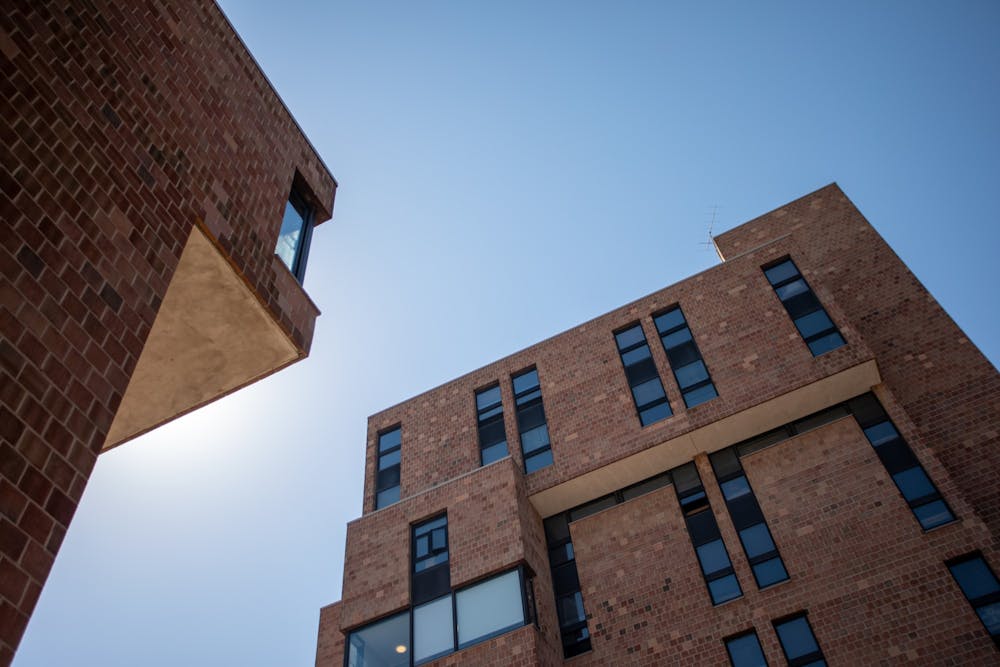There are endless rumors about UB’s Ellicott Complex — that the architect was on acid or that his child helped him design it, for example.
But one is more enduring and popular than the rest: that it was designed to prevent congregations to discourage protests and riots.
The 38-building mega-structure, affectionately nicknamed “Lego Land” by students, is infamous for its peculiar design. Ellicott looks like disjointed cubes from the side and a sprawling brick octopus from above.
Since its construction in 1974, Ellicott has been viewed by some as confusing, cramped and dismal.
“At first glance, the huge labyrinth-like Ellicott Complex… appears to have been deserted by civilization,” then-student Amy Dunkin said in an issue of The Spectrum from that same year.
The jokes didn’t die down in the years following the complex’s construction, either. Jay Rosen, then a Spectrum special features editor, quipped in a 1977 issue that“the Buffalo Bills would never lose a game there. You build the visiting team’s locker room somewhere in Ellicott…You just know the other team would never find its way out.” Even UB’s own website gracefully concedes that “Ellicott is notorious for its serpentine corridors and multiple pathways.”
Given its confounding architecture, it’s no surprise that urban legends about Ellicott’s allegedly totalitarian prison architecture have circulated for decades.
North Campus’ Rocky Start
Ellicott’s story begins far before its first brick was laid, and is deeply entwined with the history of UB itself.
After 116 years as a private institution, UB elected to join the SUNY system in 1962. School officials saw this as an opportunity to expand the university, accommodating a nationwide explosion of college enrollment.
UB projected an enrollment of 20,000 students, necessitating new construction. Administrators eventually decided to construct a new campus in the growing town of Amherst.
In 1966, when Martin Meyerson became president of the university, he consolidated 90 academic departments into seven faculties, each led by a provost.
To create a sense of community within such a large university, Meyerson envisioned creating 30 colleges of no more than 1,000 students, each with an individual identity. The “academic spine” was born.
Laid out along an east-west axis and organized by faculty and college, each school was originally intended to feature “distinct architectural expression,” according to a thesis on the design of North Campus. But to give the campus a sense of coherence, every building took on a standard color scheme of dark brown brick, a design that would eventually contribute to UB’s reputation as one of America’s ugliest college campuses.
UB broke ground on North Campus on Oct. 31, 1968, kicking off a sequence of unrest that lasted for years.
Some students quickly noticed a lack of Black construction workers on campus and wrote a resolution to the-Gov. Nelson Rockefeller, calling for the training and hiring of more Black workers. After a three-month silence on the matter, Rockefeller created a commission to investigate the issue, which halted construction.
After tumultuous negotiations, construction sputtered back into action, but the setback was the first of many incidents in which students would butt heads with university and state officials.
Shortly thereafter, students protested against UB’s choice to administer the Selective Service Qualification Test, which was meant to measure whether a college student qualified for draft deferment. These protests culminated in a brief occupation of South Campus’ Hayes Hall, an administrative building.
Then, in 1969, several Black UB athletes were in a dispute with their coaches over stipend differences. A group of white student activists from the Students for a Democratic Society protested in support of the Black athletes.
During the prolonged negotiations, some student activists broke windows in Hayes Hall. In response, UB administrators called campus security officers to arrest the students.
Students and officers ended up in physical confrontation. The activists retreated to the former Norton Student Union, barricading themselves inside.
Police eventually broke through, beating and arresting many students. The ensuing days saw more violent confrontation with law enforcement, leading to a police occupation of South Campus.
The occupation ended after nearly four months, but not before police arrested 45 faculty members for holding a sit-in at Hayes Hall.
The 1971 Attica prison riots only exacerbated tensions. These riots, quashed by Rockefeller, involved the deaths of 43 inmates and hostages. Two hundred UB students responded by protesting the state’s actions at a rally in downtown Buffalo. During the rally, police beat protestors and arrested 11, including four UB students.
Three days later, 150 students, outraged by the state’s refusal to offer healthcare to inmates injured in the Attica riots, held a sit-in at South Campus.
The Birth of Ellicott Complex
Given that history of protest, it’s no surprise that the opening of the Ellicott Complex in 1974 was a contentious affair.
During the opening ceremony, 150 students demonstrated against recent tuition hikes and faculty layoffs.
With little to no trust in UB administrators, many students believed that Ellicott’s strange silhouette was meant to suppress activism.
“[It’s] full of dead ends, isolated towers and plenty of windows — what would be handier for a potential thought police?” then-student Eric Martens said in a 1977 letter to the editor published in The Spectrum.
However, despite ongoing unrest, Ellicott was designed with Meyerson’s philosophy in mind, as all North Campus had been. The complex was meant to create many smaller communities among one larger one, not to intentionally sequester radical-minded students. In fact, UB professor emeritus of history Michael Frisch says that Ellicott actually houses ideal architecture for would-be student-rioters.
“Revolts against the state have seen more success if the perpetrators took advantage of narrow winding alleyways,” Frisch argued. “Put a bunch of protesters into the middle of a plaza and they’ll get hosed down by a couple of fire hoses. But if student radicals wanted to revolt, they could barricade themselves into Ellicott, block some entrances, open the windows to its towers and throw stones at advancing police. And the press would be able to capture the situation before the police could ever penetrate into the complex.”
Still the paranoia of students grew stronger as the social unrest of the ‘70s raged on.
In 1975, Attica prisoners began facing trial, with many UB students still rallying behind them. They sent a request to UB President Robert Ketter for funding toward bus fare so they could travel to Albany to attend the trials. Ketter denied this request, with 100 students sitting-in in response.
The sit-in abruptly escalated when a window broke and panicked students ran out of the building into the waiting police force. In the ensuing confrontation, students gathered up shards of glass and stabbed several officers. Nine students were arrested and suspended, and several officers were injured.
North Campus’ Final Form
Shaped by conflict and a diminished budget, North Campus slowly took shape. Ten new buildings were completed in 1976 and 1977, giving much needed structure to the previously isolated and desolate six-building campus.
However, some students remained skeptical. Rosen wrote an article claiming that North Campus lacked a “heart” of a student union and was designed to corral and control students.
Rosen wasn’t the only one.
“Decentralization is working because if it were not, there would be much more student protest about what is being done to us,” then-student Bernard Borthman wrote in a letter to the editor of The Spectrum. “We are being divided and conquered.”
In his own letter to the editor, then-student Kevin McCabe envisioned “totalitarian control and a serious threat to human freedom” on North Campus.
Yet, other students felt the suggestions were overblown.
“Please stop reminding us of the imperfections which exist in our would-be flawless, comfortably secure surroundings,” then-student Margaret Mary Buchanan said in a 1977 Spectrum letter to the editor.
Separated libraries, a distant university plaza and the closing of Squire Hall, South Campus’ Student Union in 1982 led to the temporary homelessness of student organizations. This further bolstered student conspiracies.
But North Campus would eventually receive its own Student Union in 1985, after many years of negotiations between students and administration. The new building, which was expanded in 1992, gave a home to 75 clubs and organizations and supplied North Campus with the “heart” that Rosen claimed it had lacked for so long.
Though imperfect and sometimes confusing or ugly, the decentralization of North Campus stems from attempts to form smaller communities within the larger university rather than a far-fetched conspiracy theory.
It may be easy to see clues pointing toward authoritarian scheming hidden in the bricks of “Lego Land,” but in the end, North Campus was malformed by state and national politics, conflicting visions and a suite of setbacks — not an Orwellian plot by the UB administration.
The features desk can be reached at features@ubspectrum.com

Dominick Matarese is the Senior Features Editor at the Spectrum. He enjoys writing about interesting people, places, and things. In addition to running an independent blog, he has worked worked with the Owego Pennysaver, BROOME Magazine, the Fulcrum Newspaper, and Festisia. He is passionate about music journalism and can be found enjoying live music most weekends.





